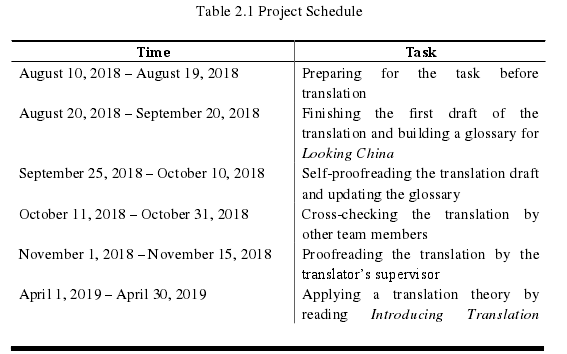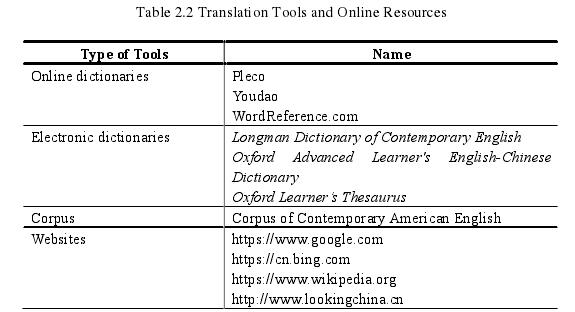本文是一篇英语论文,本报告基于《2018年展望中国青年电影》项目的汉英翻译。这位负责10000多字的作者与其他翻译人员一起工作,这要求对翻译过程进行严格控制。并对该项目进行了系统的研究,为作者成为专业翻译奠定了基础。
CHAPTER ONE INTRODUCTION
1.1 Introduction to the Translation Task
With the advancement of globalization, China has implemented projects that facilitate Chinese culture to go global. Looking China Youth Film Project, one of those initiatives, is a cultural experience program sponsored by the Huilin Foundation and hosted by the Academy for International Communication of Chinese Culture (AICCC). Looking China has been successfully run for nine rounds and is exerting increasingly extensive influence both in China and abroad. The program has become a brand of the Beijing Normal University (BNU), showcasing the kaleidoscopic aspects of China and promoting Chinese culture.
The project aims to showcase the contrasting simplicity and glamour, as well as the antiquity and fashion of China through the unique perspectives of young foreign film makers, each of whom makes a 10-minute short film of Chinese culture with the one-on-one help from a Chinese volunteer as a way to enhance the international influence and attractiveness of Chinese culture and to strengthen the cross-cultural communication, exchange and cooperation among the younger generations in China and abroad. Those international filmmakers and Chinese volunteers come from universities with world-class film and television disciplines. Starting from 2011 to 2019, the project has invited 610 foreign youths in 60 countries, completed 609 short films, and won more than 100 international and domestic awards. Seventy-seven universities have taken part in Looking China.
Looking China has created a “1+1+1+1” bilingual interactive teaching model between Chinese and foreign teachers and students. Every year, every foreign student as a director, is partnered with a Chinese student as a producer, and every team under the guidance of one international supervisor, one Chinese coordinator, and one project manager to facilitate the filming process. The project manager coordinated Chinese and foreign teachers in each shooting place, and took into consideration the training of international students and Chinese students in a cooperative manner.
1.2 Significance of the Translation Task
The significance of a text is mainly determined by its influence on the potential readers. Recent years have witnessed spurt programs dedicated to Sino-foreign cultural exchanges, which require bilingual publications to further expand public awareness of those international programs. As mentioned above, Looking China is designed to showcase the enchanting aspects of China and to promote Chinese culture to the world. In this way, translation of its publication can help to reach the goal by overcoming the language obstacles. The participants of 2018 Looking China, whether they are foreigners or Chinese, will definitely be the main target readers. Apart from the students and teachers involved in the program, more people from the cooperative universities will be attracted to get to know the program by effective publicity. The bilingual publication will be their readings and contribute to the Chinese cultural export.
In addition, since the ST focuses the whole process of 2018 Looking China program which involving 11 provinces, municipalities and autonomous regions, it contains different cultural elements which are not familiar to the foreigners, even to the author. In this case, the author has resorted to the Internet and the films made in Looking China to render the correct meanings of those Chinese cultural loaded words and expressions. Through the translation project, the author has acquired a more fundamental understanding of Chinese local customs and culture so as to contribute to her future translation.
CHAPTER TWO DESCRIPTION OF THE TRANSLATION PROCESS
2.1 Pre-translation Preparation
In the translation project, the translator, before typing the first word, tried her best to make full preparations, including a fixed schedule for the translation practice, analysis on client’s requirements, and source text analysis that can make the translator better understand the ST and achieve maximum effectiveness.
2.1.1 Project Schedule
After receiving the translation project from her supervisor as the ST of the translation report, the translator, according to the timeline for the translation report stipulated by the Foreign Language School in SWJTU, firstly set a schedule for the time of translation and report writing. The following table shows the schedule.

2.2 While-translation Process
In this part, the main focus of the translator’s attention is on the translation tools and online resources applied in the while-translation process. In addition, the translator also made a glossary for potential reference in the translation of the future Looking China projects.
2.2.1 Translation Tools and Online Resources
It is inevitable that the translator, in the course of the Chinese-English translation, will encounter a large quantity of words, phrases and sentences that she has no idea on how to render into English. Therefore, translation tools and online resources are necessary for the translator to produce an acceptable translation version of the ST. Li Changshuan (2014: 81) considered that translation tools including search engines and e-books play a key role in translation. The translation tools and online resources available to assist the translator are as follows:

CHAPTER THREE THEORETIC FRAMEWORK: TRANSLATION SHIFTS .......................... 11
3.1 An Overview of Translation Shifts Theory .......................... 11
3.2 Integrated Translation Shifts Analysis Model Applied in the Report ................ 14
CHAPTER FOUR CASE STUDY ........................... 17
4.1 Shifts Within Sentence Domain .................................... 17
4.1.1 Level Shifts ...................................... 17
4.1.2 Structural Shifts ...................................... 18
CHAPTER FIVE SUMMARY .................................. 27
CHAPTER FOUR CASE STUDY
4.1 Shifts Within Sentence Domain
The shifts within sentence domain can be divided into four types: level shifts, structure-shifts, class-shifts, and unit-shifts (rank-changes). The translator will analyze the following examples from those perspectives.
4.1.1 Level Shifts
According to the integrated translation shifts model, level shifts refer to “a SL item at one linguistic level has a TL translation equivalent at a different level”. (Catford 1965: 73) Level shifts often occur, when there is no equivalent expression in the TL, from grammar to lexis, or from lexis to grammar. For example, some concepts are expressed in grammatical form in a language. In another language it is expressed in words.
English and Chinese, falling into different language families, vary considerably. It is not difficult to find the contrast between Chinese and English grammatical structure that the prominent feature of the Chinese grammar is implicit, while the English grammar is explicit (陈宏薇,2000:152). English is an inflectional language. According to Baker (2000), the form of the verb in English usually indicates two main types of information: time relations and aspectual differences. Time relations have to do with locating an event in time. The usual distinction is between past, present and future. Aspectual differences have something to do with the temporal distribution of an event, for instance its completion or non-completion, and continuation or momentariness. On the contrary, Chinese is a non-inflectional language. Its tense and aspect are usually implied in the text through changes of the word order and functional words. More specifically, Chinese uses certain words to express tense, while tense in English belongs to the grammatical category. This kind of transfer is very common in Chinese-English translation.
CHAPTER FIVE SUMMARY
This report is based on C-E translation of 2018 Looking China Youth Film Project. The author, who were responsible for over 10,000 words, worked with other translators, which requires a strict control over the translation process. And a systemic study of this project lays a foundation for the author to become a professional translator.
When receiving the project, the author first confirmed the task volume, translation requirements and the project deadline to ensure that she was able to complete the task before the deadline. Next, she communicated with the client about the uncertainties of the translation requirements after text analysis and searched the background information of 2018 Looking China program as much as possible before translation. Meanwhile, the author also set the project schedule in the process of pre-translation preparation. Then after she studied papers related to the translation so as to select a proper translation theory for the project, she considered the translation shifts theory as the guiding principle for both the translation and proofreading. After the project was completed, the author wrote this report in which the translation was analyzed
In the report, the translation task of 2018 Looking China Youth Film Project is analyzed in detail based on the translation shifts theory proposed by Catford and through an integrated translation shifts analysis model which combines the Catford’s models with the Zoubi and Hassnawi’s. Generally speaking, the shifts in the translation can be divided into two categories, namely shifts within sentence domain and shifts beyond sentence domain. Within the sentence domain, the level shifts are the shifts from the Chinese words into English tense and aspect, and the structural shifts in the translation are mainly reflected in the change of attributive position and the transition between active and passive voices. Unit shifts analysis shows the shifts among the words, the phrases, the clauses and the sentences of the two languages. Beyond the sentence domain, the shifts occurring in the translation fall into semantic, textual, and rhetorical changes compared to the original.
reference(omitted)
